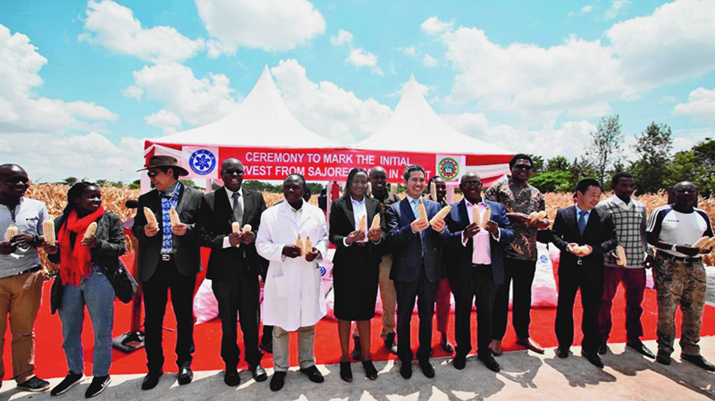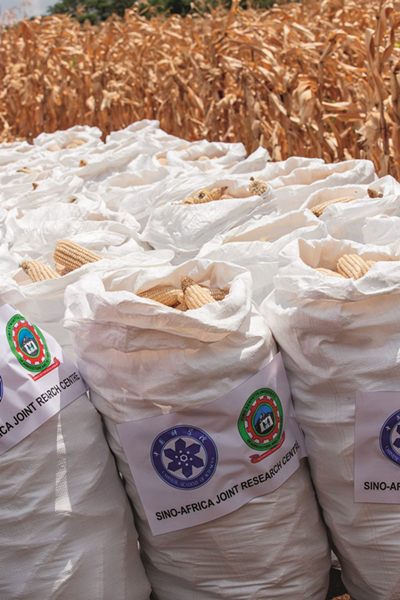|
||||||||||
| Home Nation World Business Opinion Lifestyle ChinAfrica Multimedia Columnists Documents Special Reports |
|
||||||||||
| Home Nation World Business Opinion Lifestyle ChinAfrica Multimedia Columnists Documents Special Reports |
| ChinAfrica |
| Countering the Impact Of Drought |
| Chinese and Kenyan scientists identify high-yielding maize variety and improve farming techniques amid scarce rainfall |
| By Derrick Silimina 丨VOL. 15 February 2023 ·2023-01-28 |

Chinese and Kenyan scientists unveil the first harvest of a high-yielding maize variety on 4 November 2022
For Getrude Kariuki, a middle-aged smallholder farmer in Narok County in southwest Kenya, life has been a struggle for decades, but things were never as bad as they are now.
Kariuki has seen her maize yields dwindle over the years due to scarce rainfall, especially during the 2020-2021 farming season, leaving her and many other households in the area to rely on relief food distributed by the central government.
“This is a precarious situation we all find ourselves in. With wilting crops and emaciated livestock due to droughts, there is a looming hunger crisis,” Kariuki told ChinAfrica.
Narok County, which is predominantly inhabited by the Maasai community, is one of the areas hardest-hit by droughts in Kenya, leading to food insecurity. Well known for their pastoral life and mixed farming, most Maasai farmers in this region have helplessly watched their crops wither due to persistent droughts induced by climate change.
Recently, the Narok County Drought Steering Committee estimated that over 173,000 people will be affected by the worsening drought situation in the region before the end of 2022.
In a bid to tackle the food insecurity affecting local smallholder farmers in the East African country, Chinese and Kenyan scientists have joined hands to develop a drought-resistant, high-yielding maize variety, the first harvest of which was unveiled in November 2022.
Raising maize yield
According to the Jomo Kenyatta University of Agriculture and Technology (JKUAT), the Chinese and Kenyan researchers identified the local maize variety and conducted research on viable agronomic practices like weeding and pest control that would boost its yield without altering the genetic makeup.
“This maize that we are celebrating today is a variety that can grow well in low rainfall areas and generate higher yields,” said David Mburu, a senior lecturer at the JKUAT, during the unveiling of the high-yielding maize variety at the main campus in Juja, Kiambu County.
Maize is a popular staple food on the African continent. Many people say they have not eaten unless they have had a maize meal, which is known as ugali in Kenya, nshima in Zambia, sadza in Zimbabwe, or pap in Lesotho.
Kenya, along with neighbouring Ethiopia and Somalia, is experiencing its worst drought in 40 years after two consecutive years of failed rainy seasons, leading to a reduction in maize production. The drought has wiped out livestock and crops in some regions and deepened the food crisis.
New farming techniques
Mburu revealed that after the local maize variety was planted in May 2022 on a modern agricultural demonstration area adjacent to the Sino-Africa Joint Research Centre (SAJOREC) located within the JKUAT, the maize matured at the right time, recording 2,700 kg of yield per acre (about 0.4 hectare) in the demonstration area, about 50 percent higher than the yield in the surrounding area.
Since its establishment in 2013, SAJOREC has conducted more than 45 joint research programmes focusing on biodiversity investigation, pathogenic microorganism detection, geographic science and remote sensing, high-yielding and high-quality crop cultivation demonstration, as well as land and water resources management, according to the centre.
With technical support including project funds and germplasm resources provided by the Chinese Academy of Sciences, the local university allocated 10 acres (about 4 hectares) of land as the core demonstration area for both sides to jointly use for agricultural scientific research.
“We have also done field trials in the farmers’ fields, some are arid and semi-arid areas, so this harvest means a lot to African countries. We hope to continue this project so that farmers can benefit from the research,” Mburu added.

The high-yielding local maize variety
Hub of collaboration
First of its kind in Africa, SAJOREC serves as a platform and bridge for scientific cooperation between Chinese and African scientists in a wide range of fields. It is a hub of Sino-African collaboration on biodiversity-related research, and also focuses on areas such as wildlife protection, prevention and treatment of desertification, climate change monitoring, and modern agricultural demonstration.
Leonard Gituru, a local agricultural researcher, said that the Sino-Kenyan joint scientific research programmes have not only increased the crop yield, but also improved the taste of the food and disease and pest resistance, amid climate-induced shocks like droughts.
“We hope that with SAJOREC facilities, there will be more scholarships for students so that they can help enhance food security for the farming communities in Kenya,” Gituru noted.
The research centre has also carried out substantive cooperation with universities and research institutions in more than 10 African countries, including Kenya, and trained hundreds of graduate students, management staff and technical personnel in African countries.
SAJOREC Executive Director Yan Xue noted that China’s soil moisture monitoring system will be introduced at the centre to explore a set of agricultural development paths suitable for Kenya’s climate and national conditions and help Kenya to achieve its national food security.
“The main focus of Chinese and Kenyan scientists was to embark on research on production technologies leading to improved maize harvest per acre as opposed to utilising genetic engineering,” Yan stated.
The International Food Policy Research Institute has since acknowledged that climate change is real and impacting smallholder farmers and livestock keepers in negative ways, and actions to curb it are needed at different levels.
Obert Wahome, 40, another smallholder farmer in Kiambu County, thinks that the high-yielding maize variety will reignite his interest in maize production.
| About Us | Contact Us | Advertise with Us | Subscribe |
| Copyright Beijing Review All rights reserved 京ICP备08005356号-5 京公网安备110102005860号 |